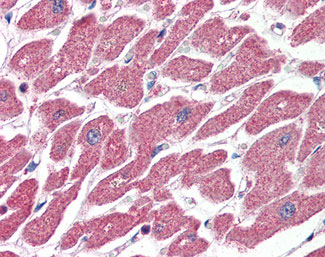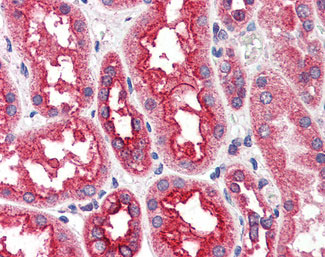CPT1A Antibody (Internal)
Goat Polyclonal Antibody
- SPECIFICATION
- CITATIONS
- PROTOCOLS
- BACKGROUND

Application
| WB, IHC-P, E |
|---|---|
| Primary Accession | P50416 |
| Reactivity | Human |
| Host | Goat |
| Clonality | Polyclonal |
| Calculated MW | 88kDa |
| Dilution | ELISA (1:128000), IHC-P (4 µg/ml), WB (0.1-0.3 µg/ml) |
| Gene ID | 1374 |
|---|---|
| Other Names | Carnitine O-palmitoyltransferase 1, liver isoform, CPT1-L, 2.3.1.21, Carnitine O-palmitoyltransferase I, liver isoform, CPT I, CPTI-L, Carnitine palmitoyltransferase 1A, CPT1A, CPT1 |
| Target/Specificity | Human CPT1A. This antibody is expected to recognize both reported isoforms (NP_001867.2; NP_001027017.1) but is not expected to recognise CPT1B. |
| Reconstitution & Storage | Store at -20°C. Minimize freezing and thawing. |
| Precautions | CPT1A Antibody (Internal) is for research use only and not for use in diagnostic or therapeutic procedures. |
| Name | CPT1A (HGNC:2328) |
|---|---|
| Synonyms | CPT1 |
| Function | Catalyzes the transfer of the acyl group of long-chain fatty acid-CoA conjugates onto carnitine, an essential step for the mitochondrial uptake of long-chain fatty acids and their subsequent beta-oxidation in the mitochondrion (PubMed:11350182, PubMed:14517221, PubMed:16651524, PubMed:9691089). Also possesses a lysine succinyltransferase activity that can regulate enzymatic activity of substrate proteins such as ENO1 and metabolism independent of its classical carnitine O-palmitoyltransferase activity (PubMed:29425493). Plays an important role in hepatic triglyceride metabolism (By similarity). Also plays a role in inducible regulatory T-cell (iTreg) differentiation once activated by butyryl-CoA that antagonizes malonyl- CoA-mediated CPT1A repression (By similarity). Sustains the IFN-I response by recruiting ZDHCC4 to palmitoylate MAVS at the mitochondria leading to MAVS stabilization and activation (PubMed:38016475). Promotes ROS-induced oxidative stress in liver injury via modulation of NFE2L2 and NLRP3-mediated signaling pathways (By similarity). |
| Cellular Location | Mitochondrion outer membrane; Multi-pass membrane protein |
| Tissue Location | Strong expression in kidney and heart, and lower in liver and skeletal muscle |

Thousands of laboratories across the world have published research that depended on the performance of antibodies from Abcepta to advance their research. Check out links to articles that cite our products in major peer-reviewed journals, organized by research category.
info@abcepta.com, and receive a free "I Love Antibodies" mug.
Provided below are standard protocols that you may find useful for product applications.
Background
Catalyzes the transfer of the acyl group of long-chain fatty acid-CoA conjugates onto carnitine, an essential step for the mitochondrial uptake of long-chain fatty acids and their subsequent beta-oxidation in the mitochondrion. Plays an important role in triglyceride metabolism.
References
Britton C.H.,et al.Proc. Natl. Acad. Sci. U.S.A. 92:1984-1988(1995).
Gobin S.,et al.Hum. Genet. 111:179-189(2002).
Kalnine N.,et al.Submitted (AUG-2003) to the EMBL/GenBank/DDBJ databases.
Napal L.,et al.J. Mol. Biol. 354:751-759(2005).
Burkard T.R.,et al.BMC Syst. Biol. 5:17-17(2011).
If you have used an Abcepta product and would like to share how it has performed, please click on the "Submit Review" button and provide the requested information. Our staff will examine and post your review and contact you if needed.
If you have any additional inquiries please email technical services at tech@abcepta.com.













 Foundational characteristics of cancer include proliferation, angiogenesis, migration, evasion of apoptosis, and cellular immortality. Find key markers for these cellular processes and antibodies to detect them.
Foundational characteristics of cancer include proliferation, angiogenesis, migration, evasion of apoptosis, and cellular immortality. Find key markers for these cellular processes and antibodies to detect them. The SUMOplot™ Analysis Program predicts and scores sumoylation sites in your protein. SUMOylation is a post-translational modification involved in various cellular processes, such as nuclear-cytosolic transport, transcriptional regulation, apoptosis, protein stability, response to stress, and progression through the cell cycle.
The SUMOplot™ Analysis Program predicts and scores sumoylation sites in your protein. SUMOylation is a post-translational modification involved in various cellular processes, such as nuclear-cytosolic transport, transcriptional regulation, apoptosis, protein stability, response to stress, and progression through the cell cycle. The Autophagy Receptor Motif Plotter predicts and scores autophagy receptor binding sites in your protein. Identifying proteins connected to this pathway is critical to understanding the role of autophagy in physiological as well as pathological processes such as development, differentiation, neurodegenerative diseases, stress, infection, and cancer.
The Autophagy Receptor Motif Plotter predicts and scores autophagy receptor binding sites in your protein. Identifying proteins connected to this pathway is critical to understanding the role of autophagy in physiological as well as pathological processes such as development, differentiation, neurodegenerative diseases, stress, infection, and cancer.



